トロピカルアイランド沖縄
Let’s be honest – if you think about colourful reefs, visibilities of over 40 meters and big fish, Japan won’t necessarily cross your mind.
Diving in the land of the rising sun? Really? Really!
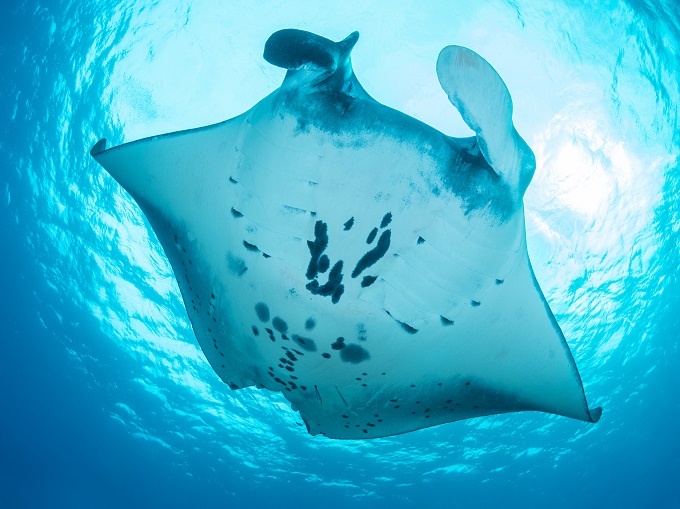
David Benz • OM-D E-M1 Mark II • M.Zuiko Digital ED 8mm F1.8 Fisheye PRO
• PT-EP14 • PPO-EP02
Japan is still completely foreign to us. It’s a white spot on the very colourful map of dive spots. Should the southwest of this foreign country possibly be put onto every diver’s bucket list? Our conclusion: Yes, it should! Okinawa and the southern islands of Japan totally prove that the Far East can compete with the great diving destinations of our blue planet.
Florian Lein • OM-D E-M1 Mark II • various M.Zuiko Digital lenses • Audio LS
If you think the island kingdom between samurai tradition and highly modern robot technology couldn’t convince us underwater, you’ll be surprised. The subtropical islands surrounded by corals are still regarded an insider’s tip amongst divers. Yet, they remind us of hotspots like Hawaii, Cancun or Southeast Asia. Japan invites us with its unique commitment to its tradition and culture. We are excited about culinary experiences, the people and everything we might find underneath the surface of the blue waters.
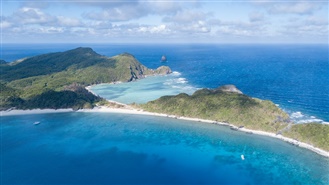 |
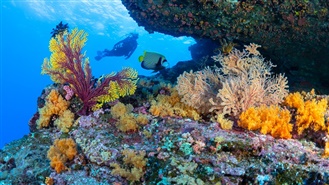 |
David Benz • OM-D E-M1 Mark II • M.Zuiko Digital ED 8mm F1.8 Fisheye PRO
• PT-EP14 • PPO-EP02
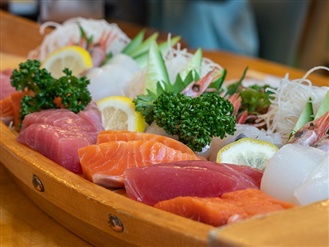 |
 |
Melanie Benz • OM-D E-M1 Mark II •
Left: M.Zuiko Digital ED 45mm F1.2 and
Right: M.Zuiko Digital ED 40-150mm F2.8
Our adventure in the Far East starts on a wonderfully sunny day on Okinawa-hontõ, the vivid main island of the Okinawa prefecture. This island is the gate to the Kerama Islands and therefore our ticket to dreamy white beaches, crystal clear water and spectacular dive sites. The islands of the Kerama archipelago seem so far off the busy hustle and bustle of Okinawa and they present themselves like the picture-perfect idyll. The tropical islands have been declared a national park in 2014 and do not only offer 248 different coral species but its deep blue waters also provide the breeding grounds for humpback whales and the grazing grounds for sea turtles. “This dive site is called Turtle paradise”, explains Toshi, our guide. “Many, many turtles!”
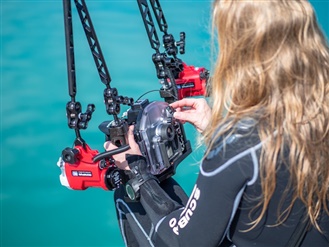 |
|
David Benz • OM-D E-M1 Mark II •
Left: M.Zuiko Digital ED 45mm F1.2 and
Right: M.Zuiko Digital ED 8mm f1.8 Fisheye PRO • PT-EP14 • PPO-EP02
Jumping off energetically, we dive in and start our Far Eastern diving adventure. And we can hardly believe what the underwater world has to offer. On just a few square metres we find so many turtles that we nearly have to be careful not to collide with them. Completely relaxed, the green sea turtles are enjoying their spa treatment on the sunny reef tops and are not feeling disturbed at all by our gazing. At a depth of around 10 metres and the best visibility possible, we count more than 20 turtles on the first sight. They submerge, they resurface.
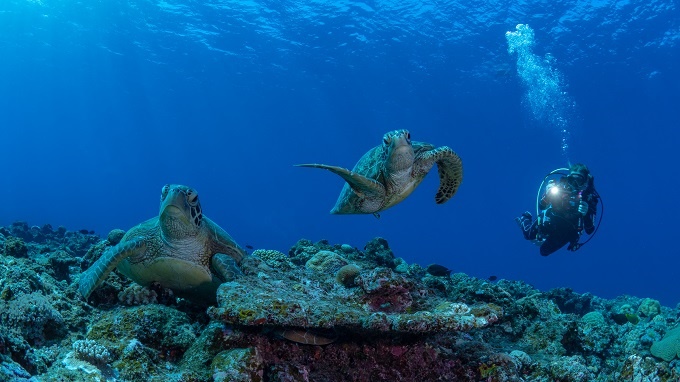
David Benz • OM-D E-M1 Mark II • M.Zuiko Digital ED 8mm F1.8 Fisheye PRO
• PT-EP14 • PPO-EP02
A complete paradise for divers and underwater photographers. The clarity of the water is incredible, its intensive, multifaceted blue is known as “Kerama blue.” After a short break above the surface we take a new shot and dive into the colourful underwater world of Japan. The sunrays are accompanying us towards the bright hard and soft coral formations. The underwater architects of Kerama have created masterful constructions – like a magical forest of different shapes and colours.
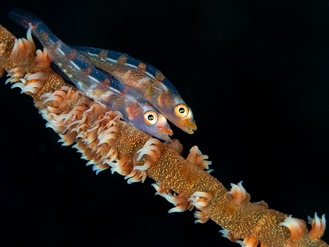 |
 |
David Benz • OM-D E-M1 Mark II • M.Zuiko Digital ED 60mm F2.8 MACRO
• PT-EP14 • PPO-EP02
We are gliding through a garden, alive and full of gorgonians, colourful fans, full of live, hustle and bustle. At the wide sandy areas, banded sea snakes are crossing our path. We encounter a manty ray here and a white tip reef shark there. The small stuff is not coming any short either. Alongside nudibranchs and orangutan crabs, cheeky clownfish and bizarre critters are posing for our underwater camera.
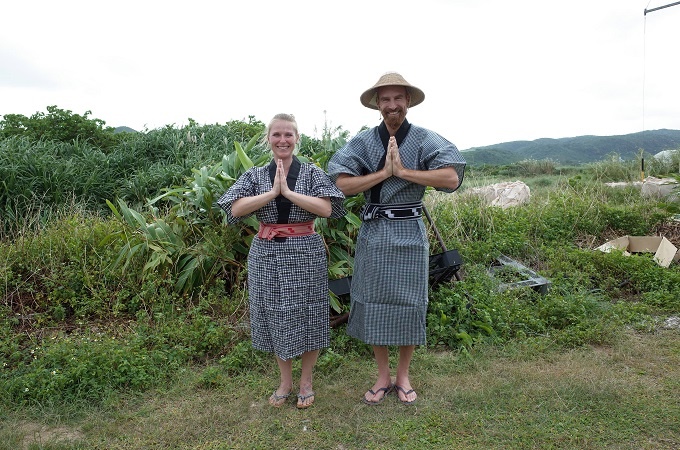
Melanie and David Benz
And Okinawa also impresses us above the surface, mostly with its ancient traditions. As Okinawa is so far from everything, is has – due to its geographic isolation – developed in a completely different way than the Japanese mainland. This is also reflected in the eating culture of Okinawa, which has little to do with the Japanese food you might know from other parts of this country. The cuisine of Okinawa bases on the splendour of the Ryūkyū Kingdom and the modesty of the poor island population. Healthy food is still very important in Okinawa. For a long time, medicine and nutrition was regarded as one and the same thing. After all, the population of Okinawa ranks among the oldest people in the world. But also, on the southern islands of the Okinawa archipelago, the inhabitants get very old, even by Japanese standards. Not for nothing, Okinawa is called the island of the one-hundred-year-olds.
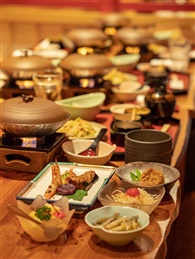 |
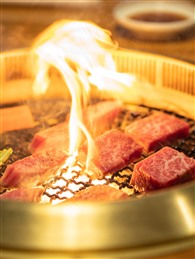 |
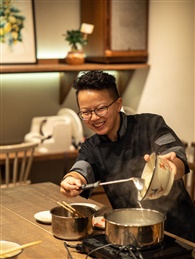 |
David Benz • OM-D E-M1 Mark II • M.Zuiko Digital ED 45mm F1.2
And as we all want to live a long life, we try Champuru, a typical stir-fry dish with tofu, meat and lots of vegetables. Yummy. Sushi, seaweeds, sashimi and sake top off the evening. And as we are trying the so-called Soba, we are asked to slurp a little more as this is the only way this noodle dish will reveal its complete flavour. No sooner said than done. Most of the food is fantastic, even if some dishes need a little getting used to. Fermented tofu, raw snails and plums pickled in salt for several months – sake is the answer to the question of how these things really taste like.

We keep on travelling and pay a visit to the Caribbean-like Yaeyama Islands, about 450 kilometres south west from the Japanese main land. The dreamlike archipelago with Ishigaki-jima, Iriomote-jima and 17 more small islands offers beautiful beaches, lush green countryside and the best dive sites in Japan – it’s the very embodiment of a Far Eastern paradise. White sandy beaches, jungle-like forests and the traditional lifestyle welcome us.
 |
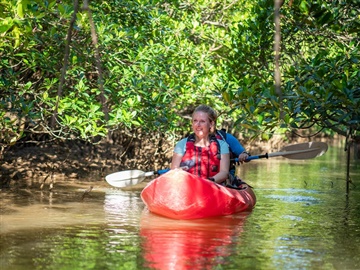 |
David Benz • OM-D E-M1 Mark II •
Left: M.Zuiko Digital ED 40-150mm F2.8 and
Right: M.Zuiko Digital ED 45mm F1.2
On Ishigaki, the second largest island of the Yaeyama Islands, we enjoy our next dive, again with a visibility of far more than 40 metres. The Kuroshio current, the “black current of Japan”, is taking our hand and takes us on a journey along densely populated reefs and rough rock formations.

David Benz • OM-D E-M1 Mark II • M.Zuiko Digital ED 8mm F1.8 Fisheye PRO
• PT-EP14 • PPO-EP02
Our guide Joshi is signalling us to stay on the lee site of the rocks and wait. We have hardly tared when the first manta ray glides through the water just above our heads. In the depth of the deep blue water we already discover more manta rays. And it’s not long before we find ourselves in the middle of a lively spectacle with 8 gracious gliding protagonists. Calmly they circle above our heads. Only after 70 minutes the underwater ballet ends its play and leaves behind speechless divers and deeply impressed faces. Our air supply is coming to an end and so, we leave the scene full of excitement and richer of one more experience: Japan’s tropical island definitely belong to the worldwide diving hotspots!
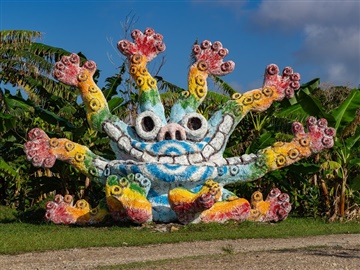 |
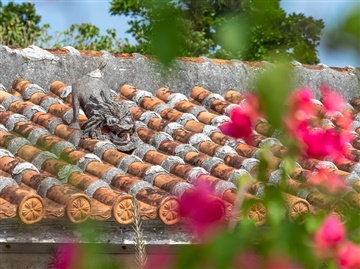 |
Melanie Benz • OM-D E-M1 Mark II • M.Zuiko Digital ED 40-150mm F2.8
Our dive free days are well spent sightseeing and – of course – with good food and some sake. In just 10 minutes the express ferry takes us from Ishigaki to Taketomi, a lively museum island of the Ryūkyū culture. In the centre, we find a flower-fringed village consisting of traditional houses with red tiled roofs, coral walls and Shiisa statues, the lion-like dog statues serving as the guardians of the houses. To not destroy the historical flair of the island, the inhabitants have joined forces and banned many modern elements from their island.
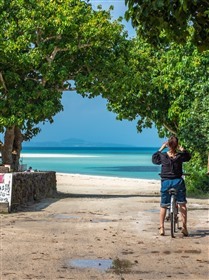 |
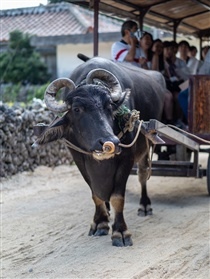 |
David Benz • OM-D E-M1 Mark II •
Left: M.Zuiko Digital ED 40-150mm F2.8 and
Right: M.Zuiko Digital ED 45mm F1.2
On streets made of coral gravel, strong water buffalos are drawing old carts, bougainvillea are covering the island with their bright pink and purple blossoms. We explore the island by bike and discover turquoise-blue-green dream-like beaches. At the Kaiji-hama beach, we can observe souvenir hunters stocking up on hoshi-suna, the tiny star sand. We enjoy the silence and uniqueness of Taketomi. With sand between our toes, stars in our pockets and sashimi in our belly, we set off for the last part of our journey through Japan where we will dive through sunken ruins and mystical underwater worlds.

Yonaguni – the Galapagos of Japan
125 kilometres west of Ishigaki, just a short distance from Taiwan, you can find Japan’s most western inhabited island – Yonaguni. The island belongs to the prefecture of Okinawa, but still it is as far away from everything as you can possibly imagine. The windswept islands do not only owe its good reputation to the strong rice liquor, the local wild horses and the attacus atlas (the largest butterfly in the world), but also to the very special dive sites that are awaiting us underneath high waves.

David Benz • OM-D E-M1 Mark II • M.Zuiko Digital ED 45mm F1.2
The rugged coastline and dramatic rock formations rather remind us of the rough coastlines of Scotland than of the tropical version of Japan. At the outermost point of the island, wild Yonaguni horses are grazing on lush green grass. Braving the stiff breeze, they pose in this picturesque setting in front of the lighthouse of Agarizaki. They are curious and intrusive rather than shy and reserved. Not long before the first cuddling is done and the first friends are made.
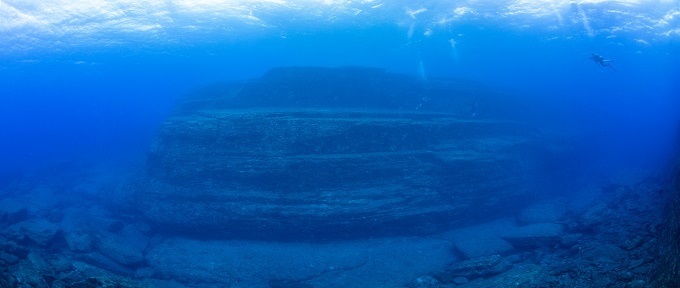
David Benz • OM-D E-M1 Mark II • M.Zuiko Digital ED 8mm F1.8 Fisheye PRO
• PT-EP14 • PPO-EP02
We are wondering if the hammerhead sharks around Yonaguni will be as curious? Their high season is from November until the end of March. During that time, you might encounter shoals of up to 300 animals which led to Yonaguni’s nickname “the Galapagos of Japan.” Again, we jump off into a crystal-clear sea and float with the current through an endless blue underwater paradise. Unfortunately, deep blue is all we see during our first dives here. No hammerhead sharks to be found. “The best time to see them is between December and February,” explains Kaoru Kawata. “In that time, you will have the chance to see the very big shoals of hammerhead sharks. And if you’re lucky, you might also see a whale shark as well.” In the evening, our host impresses us with some photographs to prove Yonaguni’s reputation as one of the best dive spots in Japan. Besides the hammerhead sharks, the island as another jewel to present: the Yonaguni Monument.
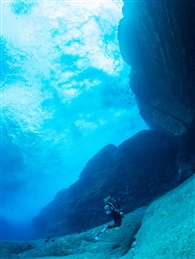 |
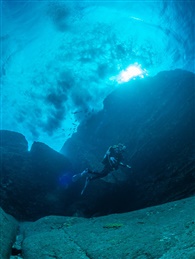 |
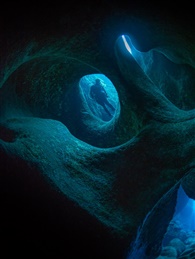 |
David Benz • OM-D E-M1 Mark II • M.Zuiko Digital ED 8mm F1.8 Fisheye PRO
• PT-EP14 • PPO-EP02
Since 1985, a unique geological formation is occupying the minds of lots of researchers, mystics and media representatives. Kihachiro Aratake, owner and operator of a dive base on Yonaguni, came across a strange, huge rock formation on one of his expedition dives in 1985. He found a nearly rectangle, asymmetrical rock with a surface of around 150 times 200 metres starting at a depth of just about 25 metres and reaching almost the surface of the water. A mystical structure with a pyramid-like look. The discovery of the underwater ruin has caused heated debates ever since. There is still a discussion about whether the Yonaguni Monument is of natural origin or made by humans. Experts say that it represents a sunken Asian culture during the ice age. Some scientists even regard the monument as the oldest building created by humans that was ever found. An archaeological sensation in the middle of the East China Sea?
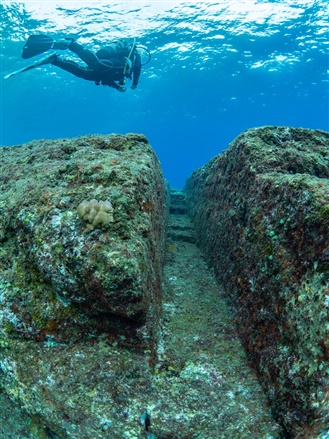 |
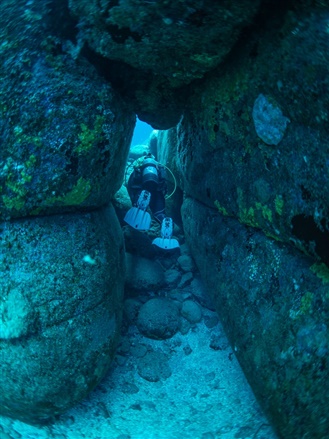 |
David Benz • OM-D E-M1 Mark II • M.Zuiko Digital ED 8mm F1.8 Fisheye PRO
• PT-EP14 • PPO-EP02
We prepare our diving and photography equipment and decide to follow the traces ourselves. We dive towards a Far Eastern Atlantis along smoothly polished plateaus. We move through very exact edges and steps. Street-like terraces and accurate canals, vertical walls with an unusual precision of the angles. Are we moving through the remains of a technologically highly developed culture or is this just the result of a natural process of erosion taking place for thousands of years? The number and exact composition of these unusual rock elements completely amaze us. The canals in front of us seem to be built with a huge saw. Everything reminds us of a sunken civilization. Or maybe not? Eventually, the Yonaguni Monument has become a destination for researchers, divers and believing searchers of the ultimate truth. The all-important question, however, remains unanswered. We are also not able to solve the riddle about the legendary Yonaguni Monument. At our dinner table, the opinions vary greatly. The only question we can agree on is the question of how we enjoyed our last meal on this beautiful adventure. “Very much”, we all answer, a glass of sake in our hand. This in mind: Kanpai and Sayōnara Japan, island paradise between old tradition and modern age, between samurai and manty rays.
This great experience was made possible thanks to the cooperation from Olympus,
ANA (All Nippon Airways) and OCVB (Okinawa Convention & Visitors Bureau)
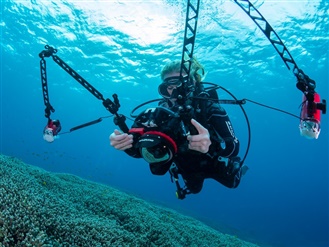
Comments
Show more comments (14)